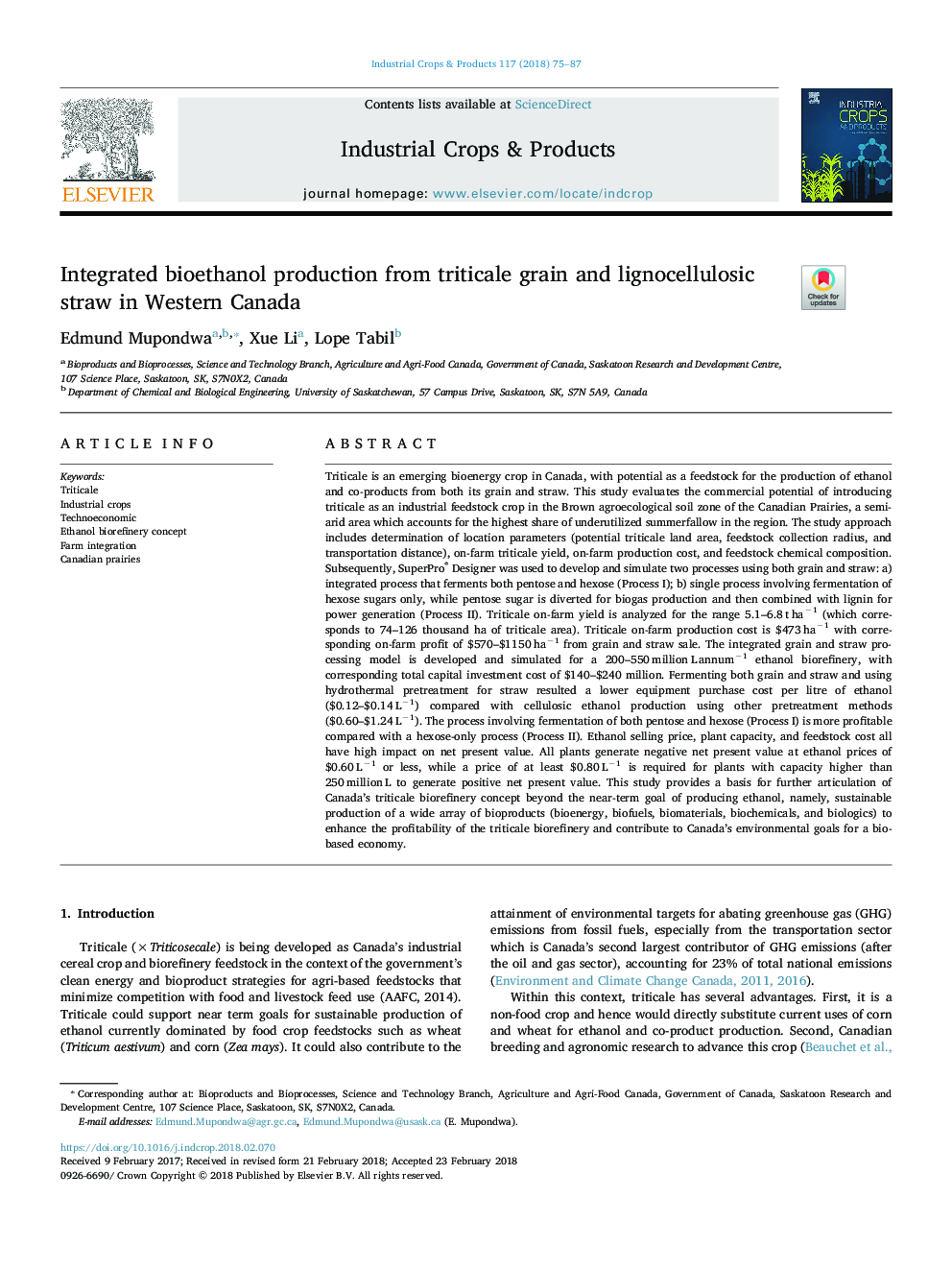| کد مقاله | کد نشریه | سال انتشار | مقاله انگلیسی | نسخه تمام متن |
|---|---|---|---|---|
| 8880193 | 1624793 | 2018 | 13 صفحه PDF | دانلود رایگان |
عنوان انگلیسی مقاله ISI
Integrated bioethanol production from triticale grain and lignocellulosic straw in Western Canada
ترجمه فارسی عنوان
تولید بیواتانول مجتمع شده از دانه های تریتیکاله و نی لیگنوسلولوزیک در غرب
دانلود مقاله + سفارش ترجمه
دانلود مقاله ISI انگلیسی
رایگان برای ایرانیان
کلمات کلیدی
تریتیکاله، محصولات صنعتی، فن آوری اقتصادی، مفهوم بیوتکنولوژی اتانول، ادغام مزرعه، استانهای کانادا،
موضوعات مرتبط
علوم زیستی و بیوفناوری
علوم کشاورزی و بیولوژیک
علوم زراعت و اصلاح نباتات
چکیده انگلیسی
Triticale is an emerging bioenergy crop in Canada, with potential as a feedstock for the production of ethanol and co-products from both its grain and straw. This study evaluates the commercial potential of introducing triticale as an industrial feedstock crop in the Brown agroecological soil zone of the Canadian Prairies, a semi-arid area which accounts for the highest share of underutilized summerfallow in the region. The study approach includes determination of location parameters (potential triticale land area, feedstock collection radius, and transportation distance), on-farm triticale yield, on-farm production cost, and feedstock chemical composition. Subsequently, SuperPro® Designer was used to develop and simulate two processes using both grain and straw: a) integrated process that ferments both pentose and hexose (Process I); b) single process involving fermentation of hexose sugars only, while pentose sugar is diverted for biogas production and then combined with lignin for power generation (Process II). Triticale on-farm yield is analyzed for the range 5.1-6.8â¯tâ¯haâ1 (which corresponds to 74-126 thousand ha of triticale area). Triticale on-farm production cost is $473â¯haâ1 with corresponding on-farm profit of $570-$1150â¯haâ1 from grain and straw sale. The integrated grain and straw processing model is developed and simulated for a 200-550â¯millionâ¯Lâ¯annumâ1 ethanol biorefinery, with corresponding total capital investment cost of $140-$240 million. Fermenting both grain and straw and using hydrothermal pretreatment for straw resulted a lower equipment purchase cost per litre of ethanol ($0.12-$0.14â¯Lâ1) compared with cellulosic ethanol production using other pretreatment methods ($0.60-$1.24â¯Lâ1). The process involving fermentation of both pentose and hexose (Process I) is more profitable compared with a hexose-only process (Process II). Ethanol selling price, plant capacity, and feedstock cost all have high impact on net present value. All plants generate negative net present value at ethanol prices of $0.60â¯Lâ1 or less, while a price of at least $0.80â¯Lâ1 is required for plants with capacity higher than 250â¯millionâ¯L to generate positive net present value. This study provides a basis for further articulation of Canada's triticale biorefinery concept beyond the near-term goal of producing ethanol, namely, sustainable production of a wide array of bioproducts (bioenergy, biofuels, biomaterials, biochemicals, and biologics) to enhance the profitability of the triticale biorefinery and contribute to Canada's environmental goals for a bio-based economy.
ناشر
Database: Elsevier - ScienceDirect (ساینس دایرکت)
Journal: Industrial Crops and Products - Volume 117, July 2018, Pages 75-87
Journal: Industrial Crops and Products - Volume 117, July 2018, Pages 75-87
نویسندگان
Edmund Mupondwa, Xue Li, Lope Tabil,
